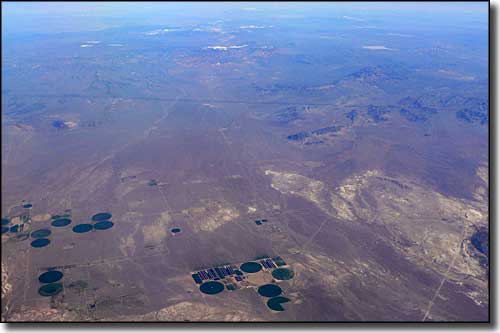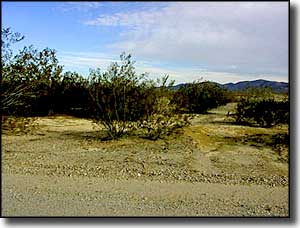 |
Amargosa Valley, Nevada |
 An aerial view of Amargosa Valley, the green circles are part of Amargosa Farms' irrigated croplands |

Amargosa Valley used to be known as Lathrop Wells. The town's southwestern boundary coincides with the California-Nevada state line and the boundary of Death Valley National Park. Some of the city's streets actually extend across that line into the national park. The town is named for the Amargosa River (named by the Spaniards for the bitter taste of its water), a typical desert river that flows for about 200 miles from its beginning in the mountains of Nevada to that place in Death Valley where it sinks into the sand. There is a 20-mile stretch of the Amargosa River near Shoshone, California that flows perenially but most of the riverbed only sees water when heavy rainfall floods the valley's washes. Most folks in Amargosa Valley live in a small area with the California border on the south and US 95 on the north. Amargosa Valley sits at the southern end of the Amargosa Desert. As barren as this area is, it shows evidence of having been frequented by humans for at least 10,000 years. During the 1800's, this was Southern Paiute and Western Shoshone country. Those two peoples were very good at living in a marginal environment. Europeans didn't start to settle in the area until the advent of borax mining in the Amargosa Desert in 1905. Within a couple years, the gold, silver, lead and borax mined in the area attracted the attention of 2 railroads: The Tonopah & Tidewater and the Las Vegas & Tonopah. Both built tracks into the valley but as usual with mining operations, the viability of those lines fell off over time. The Las Vegas & Tonopah line (fed by the main line between Las Vegas and Goldfield) was abandoned in 1918. The Tonopah & Tidewater (between Ludlow, California and Gold Center (just south of Beatty), Nevada) was abandoned in 1940. Modern development in Amargosa Valley began in the early 1950's but electric power wasn't generally available until 1963. It was the massive population growth in Las Vegas that fueled the boom in Pahrump and brought new residents to Amargosa Valley, starting in the 1990's. Amargosa Valley is near the Ash Meadows National Wildlife Refuge, a United State Fish & Wildlife Service site of about 23,000 acres that provides habitat for at least 24 plant and animal species that are found nowhere else on Earth. Several of these species are currently listed as endangered. Also nearby is Big Dune, a Bureau of Land Management site that contains a sand dune formation that rises about 300 feet above the surrounding terrain. Big Dune is open for motorized and non-motorized recreational uses. Future growth in the area will most likely be impacted by the presence of the Yucca Mountain Repository, a Department of Energy facility designed for storage of high-level radioactive waste. While the first shipment of nuclear waste materials is not scheduled to arrive until 2012, the main entrance to the facility will be in Amargosa Valley, about 14 miles south of the storage tunnels presently being built under the mountain itself. |
| Fast Facts about Amargosa Valley, Nevada |
|
Amargosa Valley, Nye County, NV 89020
Elevation: 2,640' Latitude: 36.58°N Longitude: 116.4449°W Resident Racial Breakdown: White Non-Hispanic: 64.0% Hispanic: 30.6% Native American: 0.7% Other: 0.9% Two or More Races: 3.8% Education: High School or Higher: 68.6% Bachelor's Degree or Higher: 12.0% Graduate or Professional Degree: 3.9% 2009 Estimates: Population: 1,574 Males: 800 Females: 774 Median Resident Age: 35.3 Years Estimated Median Household Income: $38,700 Estimated Median Home Value: $96,170 2011 Cost of Living Index for Amargosa Valley: 88.3 Major Industries: Mining, Lodging & Food Services, Educational Services, Agriculture, Health Care, Transportation Services, Government, Entertainment & Recreation Unemployed: 5.2% |
|
|
Nye County Related Pages
Beatty - Gabbs - Manhattan - Pahrump - Round Mountain - Tonopah - Nye County
Berlin-Ichthyosaur State Park - Belmont Courthouse State Historic Park Extraterrestrial Highway - Lunar Crater Back Country Byway Other Nye County Related Pages
Humboldt-Toiyabe National Forest - Alta Toquima Wilderness - Arc Dome Wilderness
Ash Meadows NWR - Currant Mountain Wilderness - Grant Range Wilderness Quinn Canyon Wilderness - Table Mountain Wilderness Nevada Pages |
 |
| Index - Arizona - Colorado - Idaho - Montana - Nevada - New Mexico - Utah - Wyoming National Forests - National Parks - Scenic Byways - Ski & Snowboard Areas - BLM Sites Wilderness Areas - National Wildlife Refuges - National Trails - Rural Life Advertise With Us - About This Site - Privacy Policy |
| Aerial photo of the Amargosa Desert and Amargosa Valley courtesy of Stan Shebs, CCA ShareAlike 3.0 License. Text Copyright © by Sangres.com. All rights reserved. |